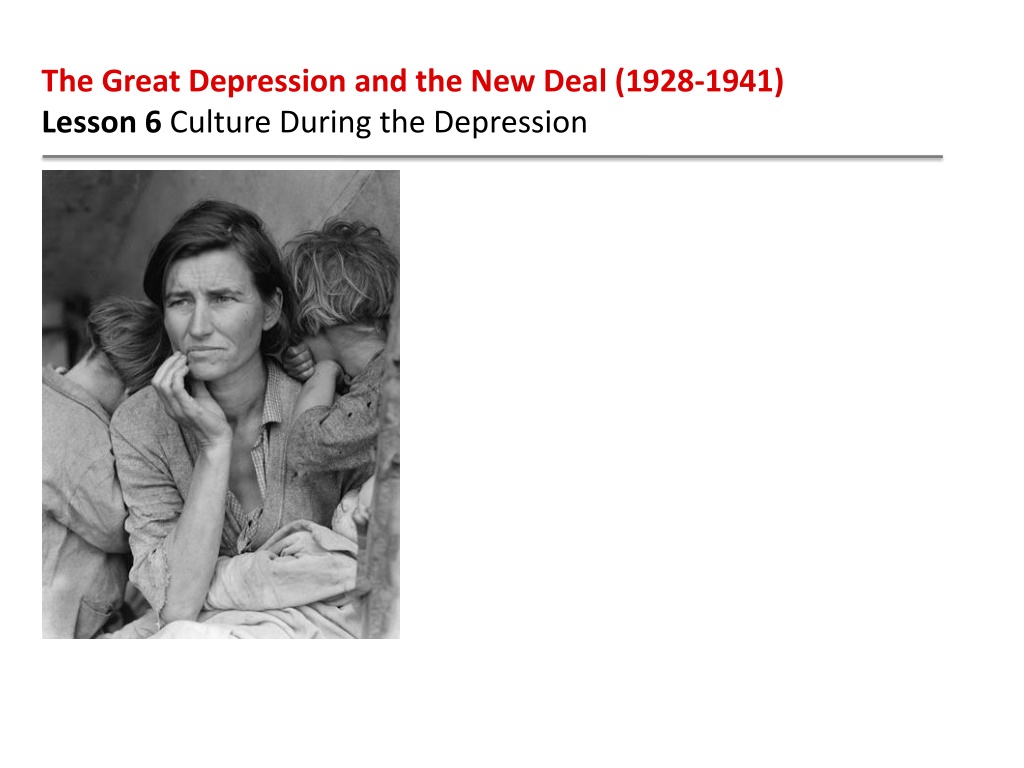
Cultural Impact of the Great Depression and New Deal Era
Explore the cultural landscape during the Great Depression and the New Deal era, focusing on the growth of radio, movies, literature, and government involvement in the arts. Learn about key figures and programs that shaped American entertainment and provided relief during challenging times.
Download Presentation

Please find below an Image/Link to download the presentation.
The content on the website is provided AS IS for your information and personal use only. It may not be sold, licensed, or shared on other websites without obtaining consent from the author. If you encounter any issues during the download, it is possible that the publisher has removed the file from their server.
You are allowed to download the files provided on this website for personal or commercial use, subject to the condition that they are used lawfully. All files are the property of their respective owners.
The content on the website is provided AS IS for your information and personal use only. It may not be sold, licensed, or shared on other websites without obtaining consent from the author.
E N D
Presentation Transcript
The Great Depression and the New Deal (1928-1941) Lesson 6 Culture During the Depression
Life During the GD, 1930s. Lesson 6 Culture During the Depression Learning Objectives Trace the growth of radio and the movies in the 1930s and how both mediums reflected to the characteristics and issues of their. Explain the relationship between the New Deal and the arts. Describe the major themes of literature in the Depression era.
The Great Depression and the New Deal (1928-1941) Lesson 6 Culture During the Depression Key Terms Frank Capra Federal Art Project murals Dorothea Lange John Steinbeck s Lillian Hellman
A New Age in American Entertainment Mass entertainment flourished during the New Deal years as Americans sought escape from the worries of the depression. And, for the first time, the government played an active role in the arts, creating programs that put artists to work. It was a golden age for entertainment, and the movies, music, and works of literature produced during this era hold a unique place in American culture.
A New Age in American Entertainment Temporary Relief From the Challenges of the Depression Depression-Era Films Reflect Social Issues Radio s Increasing Popularity The Sounds of an Era
A New Age in American Entertainment With movie attendance rising rapidly in the 1930s, actors like Judy Garland, who starred as Dorothy in The Wizard of Oz, became household names.
Increased Funding for the Arts During the New Deal, the federal government provided funding for the arts for the first time in American history. Recognizing that many artists and writers faced dire circumstances, WPA administrator Harry Hopkins established a special branch of the WPA to provide artists with work. Programs such as the Federal Art Project, the Federal Writers Project, and the Federal Theatre Project offered a variety of job opportunities to artists.
Increased Funding for the Arts The Federal Art Project employed artists to create colorful murals such as this one at the Coit Tower, in San Francisco, California in buildings throughout the nation.
The Depression Era Reflected in Literature The literature of the 1920s, from authors such as F. Scott Fitzgerald and Ernest Hemingway, sometimes overshadows the literature of the 1930s. Still, the depression era produced some memorable works in multiple genres of literature that reflected some of the issues and characteristics of their unique time.
The Depression Era Reflected in Literature American Society Under the Microscope Playwrights Champion Women and the Working Class Comics Entertain and Inspire
The Depression Era Reflected in Literature Like many other authors of the 1930s, John Steinbeck, author of The Grapes of Wrath and Of Mice and Men, wrote works that focused on the struggles of America s poor and working class.
Quiz: A New Age in American Entertainment Why did mass entertainment become such big business during the 1930s? A. Americans sought to escape their worries through movies and radio. B. High-quality movies and radio shows made the 1930s a golden age of entertainment. C. Owners of movie studios and radio networks invested in their businesses, not the stock market. D. Government played an active role in the entertainment business, funding filmmakers and broadcasters.
Quiz: Increased Funding for the Arts How did the New Deal affect American artists? A. It excluded artists from public-works projects. B. It censored art that communicated communist ideas. C. It provided artists with job opportunities and federal funding. D. It promoted specific artists and increased the value of their work.
Quiz: The Depression Era Reflected in Literature How did Superman affect the American public? A. It strengthened demands for racial equality. B. It restored widespread hope in political leaders. C. It demonstrated that ordinary people could be heroes. D. It warned people about the dangers of new technology.
